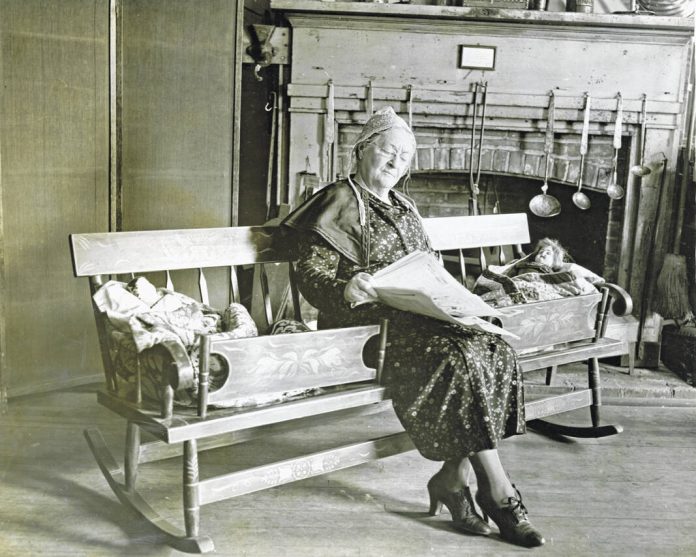
Mrs. A.T. MacDonell rocks and operates an “automatic cradle” for twins, one of the relics which WPA workers assisted in classifying and preserving at the historical society in Memorial Hall in 1936. The cradle was brought to German (now American) Township in Allen County in 1852. Mrs. MacDonell, who was treasurer of the historical society in 1936, wears a black cape and lace cap. The dolls in the cradles are also relics of early Allen County.
Courtesy of Allen County Historical Society
They were once the pride of Lima, concrete examples of President Franklin D. Roosevelt’s New Deal.
But the years took a toll. Lima Stadium, opened in 1936 with the annual Thanksgiving Day football game between Lima’s South and Central high schools, was crumbling by 2010 and was, over several years, demolished and replaced. The last swimmer clambered out of Schoonover Pool, which was leaking water at an alarming rate after nearly eight decades of service, at the end of the summer of 2019.
The stadium and the pool were but two of the more visible structures built in the Lima area during the 1930s with help from New Deal programs like the PWA (Public Works Administration), and the WPA (Works Progress Administration).
Although known for its work building schools, hospitals, roads, and other public works, the WPA also sponsored projects in the arts, employing thousands of actors, musicians, and writers.
The PWA, created in 1933, was designed to stimulate the Depression-ravaged economy by increasing employment through the construction of highways and public buildings. The WPA, voted into existence in 1935, was intended to put the jobless to work on infrastructure projects.
Between 1935 and 1943, when World War II ensured there were plenty of jobs, the WPA provided jobs for about 8.5 million people. In 1936, the Lima News reported, up to 2,000 people were employed under the WPA in Allen County, working on such projects as the completion of the Metcalf Street sewer, the Hover Lake Pump Station, shelter houses in Faurot Park, remodeling of the basement in Memorial Hall, and, of course, Lima Stadium.
On March 8, 1936, the News reported that more than 150 people were at work on the stadium project while a News story in September 1936 declared that Lima’s street improvement program, “one of the biggest ever to be undertaken,” was providing employment for “more than 700 WPA workers.”
During the summer of 1936, a handful of WPA workers was also busy on the second floor of Memorial Hall. “Five men and one woman started work Friday on the task of indexing and cataloging records and historic exhibits at the Allen County Historical and Archaeological Society headquarters on the west side of the second floor of Memorial Hall,” the News wrote July 24, 1936.
“After a record is made of each and every exhibit together with the name of the donor, the WPA employees will start work on repairing old books and newspapers which require binding,” the newspaper added. “All of the antiques will then be cleaned and placed in order.”
Under the umbrella of the WPA was the Federal Writers Project, which produced hundreds of publications, including a national guide, state guides, city guides and oral histories. A poster for the project declared that writers would “Describe America to Americans.”
“Two score reporters have been delving though musty records and documents and old histories of the district, digging for facts that have lain dormant, in many instances for years,” the News wrote in January 1936. “Not only are they putting together a detailed history of the Lima district, but their finished product will provide an up-to-date word picture of the territory in its modern setting.” The work assured “the Lima district of a prominent place in the American Guide, the government’s forthcoming five-volume travel handbook,” the newspaper added.
In May 1936, the state director of the project told the News that work on the Ohio section of The American Guide was employing more than 300 persons, assisted by 2,000 consultants and advisers. When the writers’ project put “its worn-down pencil behind its ear,” the United Press wrote in September 1936, it had produced a book of more than 40 million words. “Entitled ‘The American Guide’ and containing information about every phase of national life, it soon will go to press in hundreds of volumes at print shops throughout the country.”
On July 26, 1937, the News wrote that the Writer’s project, “though smallest in numbers employed,” had produced 32 state guides and also “conducted federal archive and historical record surveys, salvaging valuable documents.”
In Allen County, after completing work on The American Guide, writers got busy on a local guidebook, which came out in 1938. “The name of Lima is being spread from one end of the continent to the other through the ‘Guide to Lima and Allen County,’ published recently by the Lima Better Business Bureau,” the News wrote in early July 1938.
“Every family moving to the city in the future will receive one of the books by mail with a personal letter welcoming them to the city,” the News wrote in March 1938. “The books contains general information about Lima and Allen County and numerous interesting photographs.”
Photographs and artifacts from the Great Depression can be viewed at the Allen County Museum, 620 W. Market St.
.
.
SOURCE
This feature is a cooperative effort between the newspaper and the Allen County Museum and Historical Society.
LEARN MORE
See past Reminisce stories at limaohio.com/tag/reminisce
Reach Greg Hoersten at [email protected].






